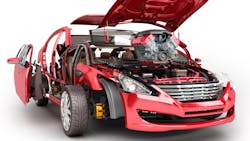Harness the chaos of parts management
Content brought to you by Auto Body Repair Network. To subscribe, click here.
As with most things in a collision center, parts management begins with the repair plan. The weaker the repair plan, the more chaos there will be in managing parts. I have visited shops that have $150,000 - $200,000 in parts assigned to works in process (WIP). I know there is chaos in their parts management when I see the portable storage containers placed throughout their parking lots.
Have a solid repair plan before the parts order
So how do we harness this chaos? Like I said, it all begins with the repair plan. Parts should not be ordered until you have a solid repair plan. Most of the dollars I mentioned above were parts ordered against a third-party estimate as a pre-order to get things moving. I must tell you the only thing that moves when you pre-order parts is money out of your bank account. I have rarely seen an instance where it helped a repair move forward in the process. Many have heard me say that the last part you find will be the first part needed to begin repairing the vehicle.
You probably wouldn’t repair a vehicle based off a third-party estimate, so why would you order parts from it? I’ve been told some third-party payers won’t let you schedule a repair until the initial parts are in. I understand their requirement, but does that really help your business and improve your repair processes? This is one area where I strongly recommend you gain control of your business, especially since it is your money you are spending, regardless if a parts deposit is made or not. Most often once the vehicle arrives for repair and the process begins, there are more parts required. Generally, it will take just as long to get all the parts you need by creating one complete parts order as it would to order that last part individually.
Validate the parts order before committing to it
While preparing for this article, backordered parts came up as I talked with shops and parts suppliers. Backordered parts are a problem, even more so when you have a customer driving a damaged vehicle around waiting on that part. Then you discover that you need more parts, or it exceeds the total loss threshold once you bring it in for repairs. I don’t have a magic answer on how to handle backordered parts, but I do know you can validate a parts order before you commit to the order. If the validation indicates a part is on a backorder list, I encourage you to perform a closer inspection of the vehicle before that part is ordered. One of the backorder part issues often discussed was the RAV4 liftgate. When I checked with Toyota’s parts department about the issue, they said they were able to fill some backorders with returned liftgates. Several collision centers I talked with mentioned they returned the liftgates because once they brought the vehicle in for repair after receiving it, additional damage was found that pushed the repair above the total loss threshold.
Steps you can take to harness the parts chaos
Here are a few steps you can take to harness the parts chaos. First, look at your current WIP to identify which repairs are waiting for parts. Next, validate that you have a solid repair plan for those vehicles. If you don’t, you should create one before those parts arrive. You may have to do some disassembly or measure the vehicle to validate you have everything needed once the parts come in. The issue with the RAV4 returns was that repairers found aperture, floor and rail damage once the vehicle was disassembled after the liftgate arrived. To prevent further parts WIP issues, I encourage you to question two things: is the repair $4,500 or more? And is it 50 percent of the total loss threshold? A majority of the WIP I reviewed that were waiting on parts were in those two categories. And several of those upon further inspection required additional repairs that exceeded the total loss threshold. If you make these checks before you order parts, you might find you don’t actually need parts, as your inspection will prove the vehicle to be unrepairable.
Parts procurement will always have issues and concerns. I hope I have offered some solutions to harness some of the parts chaos you face. We all know a collision center does not show any profit in a repair until the vehicle is delivered. I believe anything you can do to reduce your expenses during the course of a repair develops sustainability in your business overall. I am not sure how many collision centers can afford the $150,000 - $200,000 in parts WIP, but I am sure it is a strain on most. To bring some stability to your parts program, I encourage you to review your parts ordering processes today. Determine the quantity of parts you are returning as well as the number of parts orders you are making per repair.
Read the article? Get AMI credits!
This article is worth .25 credit hours toward Automotive Management Institute (AMi) designation programs. To receive credit, log in or set up a free “myAMi” account at ami.knowledgeanywhere.com. Then click here or search for "Harnessing the chaos of parts management" to get to the quiz.
About the Author
John Shoemaker
John Shoemaker is a business development manager for BASF North America Automotive Refinish Division and the former owner of JSE Consulting. He began his career in the automotive repair industry in 1973. He has been a technician, vehicle maintenance manager and management system analyst while serving in the U.S. Air Force. In the civilian sector he has managed several dealership collision centers, was a dealership service director and was a consultant to management system providers as an implementation specialist. John has completed I-CAR training and holds ASE certifications in estimating and repair. Connect with Shoemaker on LinkedIn.

